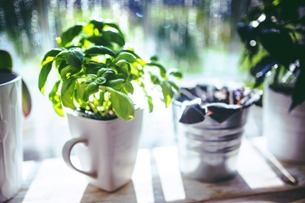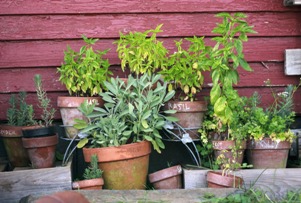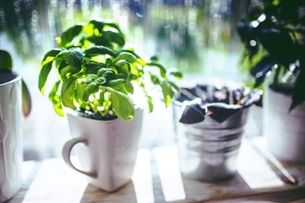Chives, oregano, rosemary, thyme, basil, balm, mint and other herbs don’t require special treatment, all they need is enough light and water. Fresh herbs will enhance your dishes to another dimension and scent your home with the call of nature.



How to grow these healthy and tasty ingredients? Let’s have a look at some advice and tips for cooks, gardeners or promising growers.
Where to grow herbs?
Thanks to special terracotta pots, you don’t need a garden to create a bed of herbs. A high container with several side holes can be used to plant more types of herbs at once and appreciated even on a smaller balcony. However, terracotta pots dry out fast, so don’t forget to water the plants regularly to keep the soil damp./p>
Window flower boxes or ordinary pots on window sills can be used, too. Ground herbs such as thyme or marjoram look great in hanging containers. They will always come handy in the kitchen without taking space on the worktop.
Tips for growing herbs outside and in a flat
If you plant herbs into interior containers, don’t use the soil from the garden – it might contain insect. Buy special earth for growing herbs. Herbs require a lot of light. They need it to grow fats, and it helps them to produce essential oils which give the herbs a specific taste. In winter, when the days become shorter, use artificial light.
If you have compost, use it when planting herbs in the garden in the spring. A layer of compost is enough to fertilize the herbs for the whole year. Herbs also flourish in vegetable beds. Different cultures enrich one other – basil is beneficial to tomatoes, caraway to potatoes. If you don’t not feel like fiddling about with seedlings, save your time by buying the herbs at farm markets from organic farmers.
Recluse herbs
Too invasive herbs should be grown separately. One example is mint which can push other herbs out of the garden or flower box. Mint prospers in moisture, so it needs frequent watering – or place the pot near a water tap to catch a lot of drops.
Rosemary should be grown separately as well. This bush grows fast and rivals the surrounding plants. During the winter, put rosemary inside, where it won’t be exposed to too low temperatures.
It is more practical to grow annual plants which have to be planted every year (such as basil, coriander, marjoram, chilli) in one box and herbs which can survive the winter in another one. Mint, oregano, chives, thyme and sage can stay outside all year long.
Did you know that… 1. …thyme loses its quality after two to three years? After a while, you should grow a new plant. 2. …sage and dill shed seeds themselves? If you don’t want to have them all over your garden, remove their flowers. 3. … comfrey leaves are good for compost? They are rich in nitrogen and help to decompose organic material. 4. …rubbing lavender leaves will remove the unpleasant smell of garlic or onion? 5. …anise and basil attract useful insect to the garden?
How to harvest and store herbs
A traditional way of preserving the smell and taste of herbs is drying. If you decide to store herbs for winter, harvest them in the middle of summer, just before they blossom, ideally in the morning, after the dew drops down and before the sharp sunlight. Herbs are the most intensive at this time. Cut the herbs either branch by branch or about 15 cm from the upper side of the stem. Rinse the herbs, shake off the water, and lay out the leaves on newspapers. Dry them at room temperature until they are fragile enough to fall apart.
If you contend with high humidity, put the herbs in the oven for a few minutes. Set a moderate temperature, bellow 65°C, and leave the oven door slightly open and let the humidity out. The result will be perfect.
Drying seeds can take two weeks. Try hanging a bundle of herbs in a small paper bag (paper absorbs humidity.). When dry, the seeds fall on the bottom of the bag.
Photo – source: Pixabay.com, Dreamstime.com





